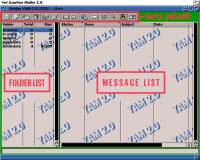

| PD/S World - YAM 2.0 |  |
![]() Every new release of a package is often introduced as
revolutionary, an incredible occasion to double one's own
individual productivity (after few releases we would be in a position
to build a skyscraper of twenty floors with the only power of the
mind...;). YAM has reached the 2.0 release and, doubting
this turns over the fates of the planet, it' s introduced like a
mature and performing product.
Every new release of a package is often introduced as
revolutionary, an incredible occasion to double one's own
individual productivity (after few releases we would be in a position
to build a skyscraper of twenty floors with the only power of the
mind...;). YAM has reached the 2.0 release and, doubting
this turns over the fates of the planet, it' s introduced like a
mature and performing product.
 From oblivius time, YAM keep the role of the firstlady
in the field of mailers for Amiga. The appearance, in
recent years, of equally valid electronic mail managers (commercial
or not), has not managed to undermine from the throne the
Marcel Beck creature; the optimal stability, the compactness, the possibility
of configuration (within sure limits) of the intuitive user interface
(based on MUI) together with the nature of the program itself (it's
completely free), are the qualities that mainly allowed to
this package to spread itself as an oil spot (collecting enthusiastic
consents), ruining, in fact, the very fierce competition.
From oblivius time, YAM keep the role of the firstlady
in the field of mailers for Amiga. The appearance, in
recent years, of equally valid electronic mail managers (commercial
or not), has not managed to undermine from the throne the
Marcel Beck creature; the optimal stability, the compactness, the possibility
of configuration (within sure limits) of the intuitive user interface
(based on MUI) together with the nature of the program itself (it's
completely free), are the qualities that mainly allowed to
this package to spread itself as an oil spot (collecting enthusiastic
consents), ruining, in fact, the very fierce competition.
|
First steps The archive (a bit more than 600k in .lha compression) can be downloaded from the support site (www.yam.ch), or from any Aminet mirror; once unpacked and installed, the package occupies approximately a mega and half.  We shall remember to whom is in possession of faster machines, that in addition is present
a file (about 500k) recompiled expressly for more powerful CPU (040/060) .
We shall remember to whom is in possession of faster machines, that in addition is present
a file (about 500k) recompiled expressly for more powerful CPU (040/060) .Clear and intelligible, the start panel is occupied, in its greater part, from a folders window and a message window, placed over it. Moreover is present a series of push-buttons through which you can approach to the main commands of the program: we report, at a stretch, nomenclature and respective function. Starting from left, here are listed the main functions we can call from the toolbar:
|
|
 Letters to a professor
Letters to a professor
For the composition of your own messages, YAM puts to
disposition a comfortable panel subdivided, like a ''card-holder'', in
three parts: the first (Message), concurring (obviously)
at the writing of the text, allows you to insert separators
(of thin and thick type), emoticons you stored before (of insufficient
usefullness), to carry out cut & paste operations, to
use a glossary and to have resort, if desired, also to an
external editor (by default the worst Commodore Ed); the
second section (Attachments), consists in the possibility to enclose
to the message files of any kind (images, sound samples,
etc.); finally, the third (Options), concurs to add signature
at the end of the text, encrypt the messages,
to decide the type of ''importance'' (low, normal and
high) for the email, to select more adressees for the same letter,
to automatically delete the email after transfer and visualizing the
''return receipt' ' (useful in order to verify if the message has
reached the address).
|
Obviously, the greater part of the operations is carried out
with extreme semplicity: thanks to the clean structure of the
program, the understanding of the functions needs, also to
the neophyte, little less than some minute.
Dear Diary
Besides the email fields (Alias, Real Name,
address, etc), The YAM AddressBook puts to disposition
appropriate spaces for ''snail mail'' (City, Street, Telephone
Numbers), for generic information (date of birth and description of
the concerned person) and for scansions of thumbnails in .iff format;
this last particularitity, representing a frivolity above
all, shows the extreme care used to develop the package.
|
|
| Total: 94% One of best PD programs of 1999 |
 |
|
. |
We remember that Italian localization of the program has been saw from Joachim Thomas, Stefano Guidetti, Francisco Mancuso, Francisco Cells
| Contact: For this article: macitsan@tin.it English version: hooligan@libero.it General info: info@amiworld.it |